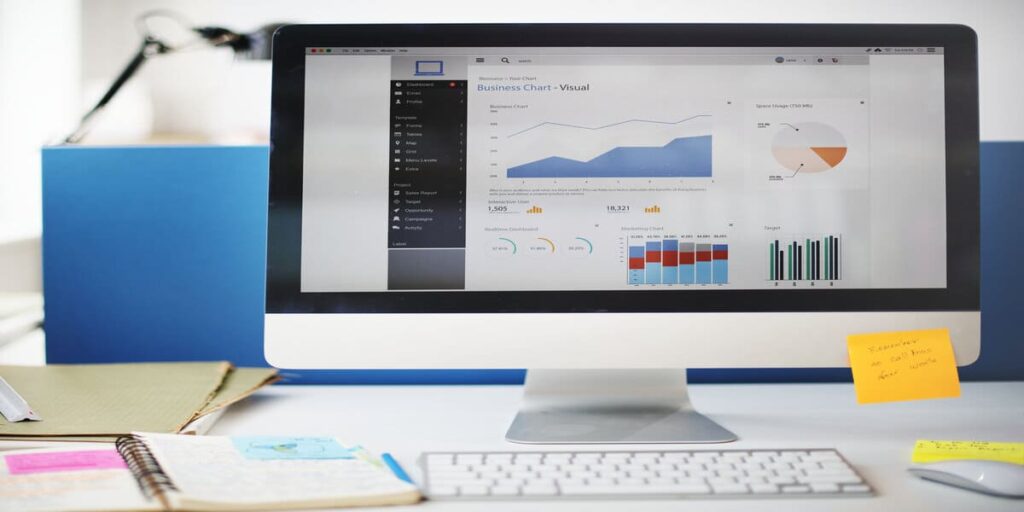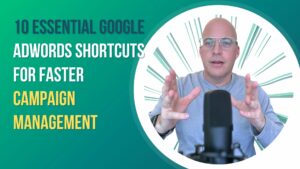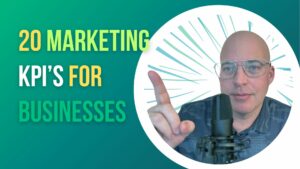Having Trouble Proving Your PPC Campaigns’ Worth? Learn to Set KPIs and Metrics That Link Directly to Business Goals at Every Stage of the Marketing Funnel.
When working with a new PPC, the first step is setting goals that align with the overall business aims. Often, many people do not have well-defined goals for their campaigns, typically focusing only on increasing traffic or conversions.
We will look into establishing effective key performance indicators (KPIs) and metrics that correspond with your business objectives at each marketing funnel stage.
Differentiating Between PPC KPIs and Metrics: Understanding Their Distinct Roles
Understanding the distinction between PPC KPIs and metrics is inportant for setting up successful campaigns.
KPIs represent the ultimate objectives you aim to achieve. Conversely, metrics are the specific data points that track your progress toward these objectives. For instance, if increasing qualified leads is your goal, relevant metrics might include the conversion rate or the number of new users visiting a particular webpage.
PPC campaigns serve various purposes, so it’s important to understand how KPIs and metrics differ. Choosing the right KPIs for your business and connecting them to appropriate metrics is vital for success.
Often, people use the same goals for all campaigns, regardless of where they fit in the marketing funnel. However, it’s more effective to customize goals and metrics according to the specific funnel stage. This approach allows for a more precise measurement of campaign performance.
Importance of Tailoring PPC Goals to Different Stages of the Marketing Funnel
Focusing solely on bottom-of-funnel marketing through paid search can be a limiting strategy.
PPC campaigns have the potential to support every segment of the marketing funnel if they are appropriately structured and evaluated against relevant metrics and benchmarks for each stage.
A common oversight is the application of uniform goals across campaigns at different funnel stages. This approach fails to recognize the necessity of aligning campaigns with stage-specific objectives, necessitating distinct KPIs and metrics for a more accurate and fair assessment.

Strategies for Effective Top-of-Funnel PPC Campaigns
Top-of-funnel campaigns aim to generate awareness among audiences unfamiliar with your product or service. The goal is to reach a wide pool of potential and future customers, sparking their interest.
Prioritizing reach, these campaigns typically leverage ad types that offer high visibility at a lower cost.
Given PPC’s common association with bottom-funnel tactics, you must distinguish top-of-funnel strategies in your overall PPC marketing plan.
These campaigns often employ platforms like the Google Display Network, which has its benchmarks, ad content styles, and advantages.
To accurately assess the success of your top-of-funnel efforts, use KPIs and metrics tailored to this specific stage of the marketing funnel.
Key Performance Indicators for Top-of-Funnel PPC Efforts
- Elevate Brand Recognition: Measure the increase in brand awareness and recognition through metrics like search volume for brand-specific terms and brand mentions across platforms.
- Grow Website Visits: Track the rise in the number of visitors to the website, especially new users, as a result of pay-per-click (PPC) campaigns.
- Enhance Social Media Interaction: Assess the growth in interactions on social media platforms, such as likes, shares, comments, and direct messages linked to PPC efforts.
- Amplify Brand Engagement: Monitor the increase in overall engagement with the brand, including time spent on the website, repeated visits, and participation in brand-related activities or discussions.
Metrics to Track in Top-of-Funnel PPC Initiatives
- Number of Impressions: This metric indicates the total number of times your PPC ads are displayed, providing insight into the reach of your advertising efforts.
- Cost Per Thousand Impressions (CPM): This measures the cost for your ad to be shown 1,000 times, helping to evaluate the financial efficiency of your ad reach.
- Click-Through Rate (CTR): CTR is the percentage of impressions that resulted in a click, showing how effective your ads are at capturing audience interest.
- Engagement Metrics in Google Ads: These include detailed interactions such as video views, clicks on call-to-action buttons, and other specific user actions, offering a deeper understanding of how users engage with your ads.

Guidelines for Mid-Funnel PPC Campaigns
Mid-funnel campaigns cover a broad spectrum of goals and strategies, including:
Various types of Display ads: These appear on websites, apps, and social media platforms, leveraging visual elements like images, videos, and rich media to attract attention and generate interest among a wide audience.
Search ads: These are text-based ads that appear on search engine results pages. They are triggered by specific keywords, targeting users actively searching for related products or services.
Dynamic search ads: These ads automatically generate ad headlines and landing pages based on the content of your website. They are particularly useful for targeting searches that are relevant to your content but might not be covered by your existing keywords.
Numerous other formats: This can include various other ad types like video ads, social media ads, native ads (which match the look and feel of the platform they’re on), and more. Each format is designed to engage potential customers in different stages of the discovery and decision-making process.
The key aspect of these campaigns is their focus on the Interest/Consideration phase of the user journey. Therefore, the KPIs and metrics selected should align with this goal, aiming to engage users who have shown interest in your product or service and guiding them towards a decision.
Key Performance Indicators for Mid-Funnel PPC Efforts
Build Industry Credibility: Track the increase in industry authority and trust, measured by factors like the frequency and quality of interactions with industry influencers, mentions in industry-specific publications, and backlinks from reputable industry websites.
Boost User Engagement: Measure the rise in user interaction with your content and offerings, including metrics like time spent on specific web pages, interaction with educational content, and repeat visits.
Encourage User Consideration: Assess the growth in actions that indicate users are considering your products or services, such as increased downloads of product information, sign-ups for webinars or demos, and inquiries about product features or pricing.
Foster Lead Nurturing: Monitor the effectiveness of lead nurturing efforts by evaluating metrics like email open and click-through rates for nurturing campaigns, progression of leads through the sales funnel, and interactions with personalized content.
Metrics for Evaluating Mid-Funnel PPC Campaigns
Micro-conversions like demo sign-ups or PDF downloads: These metrics focus on specific actions taken by users, indicating their interest beyond basic interaction, such as signing up for product demos or downloading informational PDFs.
Click-Through Rate (CTR): This measures the percentage of people who clicked on your ad after seeing it, reflecting how compelling your ad is to your target audience in prompting a response.
Bounce Rate: Bounce rate tracks the percentage of visitors who navigate away from the site after viewing only one page, indicating how well the site content meets the expectations set by your PPC ads.
Engagement Rate as measured in Google Analytics 4 (GA4): This metric evaluates the quality of user interactions on your site, such as time spent, interactions with content, and completion of set goals, providing a comprehensive view of user engagement.

Focus on Bottom-of-Funnel PPC Campaigns
Bottom-of-funnel PPC campaigns are typically what many imagine when discussing PPC. These efforts drive specific actions such as form submissions, phone calls, purchases, and quote requests.
These efforts often involve:
Search campaigns using highly targeted, high-intent keywords.
Display remarketing campaigns that re-engage users from mid-funnel activities to further guide them down the funnel.
Key Performance Indicators for Bottom-of-Funnel PPC Strategies
Gain New Customers: This KPI focuses on the number of first-time buyers acquired through PPC campaigns, indicating the effectiveness of these campaigns in converting prospects into new customers.
Boost Revenue: Track the increase in total revenue attributed to PPC initiatives, reflecting the direct financial impact of these campaigns on the business’s bottom line.
Generate Quality Leads: Measure the number and quality of leads generated, focusing on those most likely to convert into customers due to targeted PPC campaigns.
Increase Purchase Numbers: Monitor the rise in the number of transactions or purchases made, indicating the success of PPC strategies in driving more sales and repeat purchases.
Essential Metrics for Bottom-of-Funnel PPC Campaigns
Primary Conversions (such as form submissions or purchases): This metric tracks the number of key actions completed, like form submissions or actual purchases, which are direct objectives of the PPC campaign.
Conversion Rate: This measures the percentage of users who complete a desired action (like a purchase) out of the total number of visitors, indicating the campaign’s effectiveness in persuading users to convert.
Cost per Acquisition/Conversion (CPA): CPA calculates the average cost spent on PPC to acquire a customer or achieve a conversion, helping assess the financial efficiency of the campaigns.
Return on Ad Spend (ROAS): ROAS assesses the profitability of the PPC campaigns by comparing the revenue generated from ads to the cost of those ads.
Average Order Value (AOV): This metric averages the value of each purchase, indicating the spending behavior of customers acquired through PPC campaigns.
Cart Abandonment Rate: This rate measures the percentage of users who add items to their cart but do not complete the purchase, highlighting potential issues in the checkout process or customer hesitations.
Quantity of Items Purchased: This tracks the total number of items sold through the PPC campaigns, offering insight into product popularity and buying patterns.
Understanding Paid Search Attribution in Google Analytics 4 (GA4)
The approach to marketing attribution can significantly alter how you assess your PPC campaigns’ performance.
Typically, PPC campaigns on Google and Microsoft Ads default to a last-click attribution model unless you opt for a data-driven attribution model.
In a notable update in July 2023, Google declared the retirement of several attribution models, including first click, linear, time decay, and position-based models.
Google Analytics 4 (GA4) adopts a cross-channel data-driven model as its standard for attribution. Additionally, GA4 offers options for paid and organic last-click attribution and a specific last-click model for Google paid channels. These models can be applied to certain reports at the property level.

Aligning Metrics and KPIs with Business Objectives
Sometimes, broad business goals directly correspond to specific KPIs and metrics. However, there are instances where you might need to align the PPC strategies with overarching business objectives creatively.
One of the biggest errors is establishing KPIs and metrics that don’t support business success. A close second is the inability to clearly and succinctly demonstrate how these KPIs and metrics contribute to the company’s success.
Often, the challenge lies in securing support and budget from key decision-makers. It aids them in understanding the connection between your efforts and the company’s goals. You can highlight their value effectively by clearly articulating how your KPIs align with the company’s mission and objectives
Tailoring KPIs and Metrics for Effective PPC Management
Your PPC campaigns’ key performance indicators (KPIs) must be closely linked to your business goals. The metrics chosen to evaluate these KPIs should be based on your business’s specific nature and the structure of your campaigns.
To set yourself up for future success, avoid the pitfall of applying generic KPIs across all your efforts. You’ll achieve better results – and likely impress your boss or client more – by customizing your KPIs according to the specific stage of the marketing funnel that your campaigns target.








